
Chefs reveled in creation.
Vietnamese taste
affirmation
In
the northern semi-final round of The Golden Spoon Contest 2016, Indochine
Palace Hue team brought a casual yet elaborate dish: luffa (Luffa aegyptiaca) and wild maracuji (Passiflora foetida) soup.
Those
are humble and acquainted vegetables with most of people in the Middle of
Vietnam. “Wild maracuji has different usages. In many countries, people have
used this leaf as a type of sedative to support heart rate and anti-insomnia.
To complete the dish and make an integration with international cuisine, we
have created a resonance between Vietnamese traditional dish – luffa soup – and
European shrimp cake”, presented chef Tran Huy Cuong.
The
broth of this soup was from boiling luffa and wild maracuji leaves to
medium-cooked to preserve the leafy color. Wild shrimps caught in Tam Giang
lagoon would be sautéed to serve together.
Shrimp
cake was made from grinded fresh shrimps, egg whites, and seasonings (black
pepper and hot pepper) then steamed until cooked.
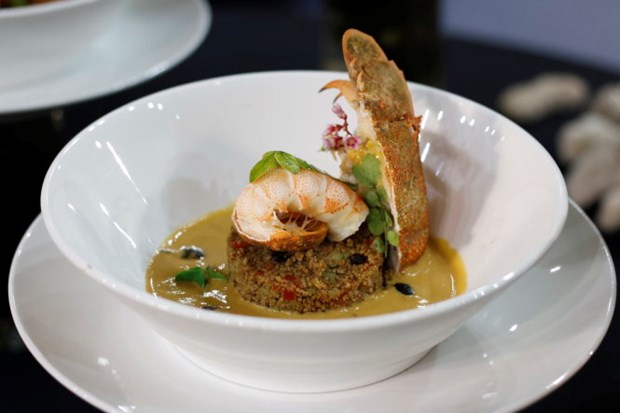
Ly Son oyster salad, served with New Zealand lobsters and Ly Son sea-cucumber.
“The
important tip to cook this dish is to control cooking level of ingredients to
retain their freshness and leafy color – the color should be natural green, the
taste should be transparently sweet from luffa and wild maracuji leaves, and
shrimp cake should be enough tender.
The
resonant sweetness between shrimps and whipping cream creates a fresh and
delightful taste. Even though it’s just a casual, regional soup, we still can
elevate it to a national contest by our creative and delicate cooking method”,
said chef Cuong.
With
the same spirit of renovating traditional Vietnamese food, Muong Thanh Lao Cai
hotel team surprised everybody by its creative dish: Ca Ra crabs with water
spinach (Ipomoea aquatic). Ca Ra is a wild river crab and highly sweet. They
naturally live in Cau river, Thuong river, and Luc Nam river (Bac Giang
province) and have the peak season from September to October, when they are so
meaty and flavorful.
First,
Ca Ra crabs would be smashed, filtered then boiled to collect “gach” – the
protein agglutinating together. This plague was well mixed with smashed black
tiger prawn, pork paste, and a handful pepper and Welsh onions. This paste was
stuffed back into crab shells, boiled in a pot until cooked then drop chopped
water spinach in. The broth would have yellowish color of crab eggs.
“To
have a qualified soup, crabs must be smashed, not grinded, to eliminate flesh
and eggs. Therefore we can distinguish the flesh and the eggs combined into a
flavorful bite.”, said chef Lien.

Sweetie Strawberries.
Fading Ingredients
In
The Golden Spoon last season, Binh Quoi 1 Resort claimed its reputation by winning
a double-1st-prize, which was in Ho Chi Minh city preliminary and
southern semi-final. This season, the history has just repeated. What is so
special in the menus of chef Le Vo Anh Duy this year?
Truc
Linh vegetables is believed to help reduce motion sickness and to support
body’s health. Chef Anh Duy rolled them by thin slices of calf shank, which is
so tender and enough crunchy, and bathed those rolls in hot wild black pepper
sauce.
In
Middle scanty countryside, Truc Linh vegetable grows all over the place like
pennywort or rau den (amaranth) but it really inspired this talented chef.
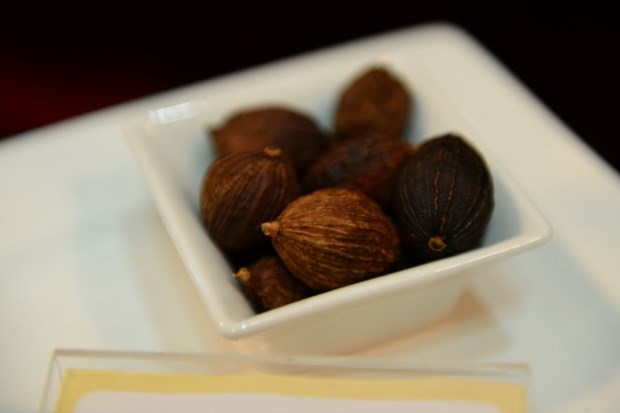
Thao qua (Amomum tsaoko).
Truc
Linh vegetable is much crunchier when soaked in ice water. In farm markets,
this vegetable has been popularly sold but not in southern areas. This rustic
ingredient and hot buttery pepper sauce did overthrow the jury since the first
taste.
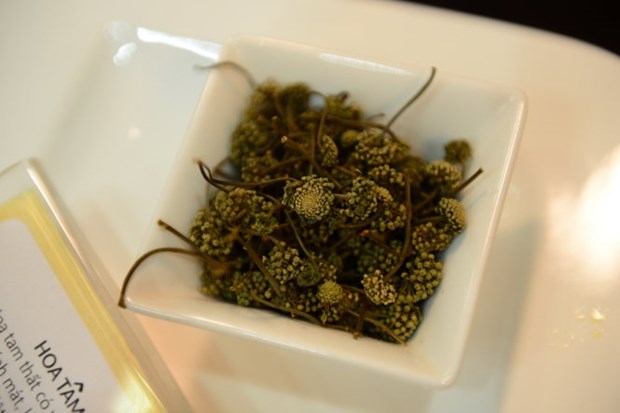
Tam That flowers (Panax pseudoginseng).
The old
southwest people have not stopped thinking of their fading regional
ingredients, such as Hu Thom root or Mo Qua flowers (Dischidia major). However, there are always gourmets who try to tame those delicacies at
home.
Mo Qua tree just strongly
grows in uncultivated grassy soil. In order to tame them, people have to gather
many of them in that specific area and wait till its season.
Mo Qua fruits only bear
in the end of autumn, meaning nobody can have them at the southern semi-final
round of The Golden Spoon 2016. Therefore, chef Nhi (Nhi Restaurant – Can Tho
province) decided to use Mo Qua flowers instead.
Mo Qua flowers, which is
considered as liver supporter, and crunchy and tasty Hu Khom root were mixed
with shredded grilled wild blotched snakehead (Channa maculate) to become a wake-up call to every sense. Elite
Artist and Guest judge Kim Xuan gave comment that they tasted even sweeter than
termite mushroom (Macrolepiota albuminosa).
This was just a great
discovery of chef Nhi.
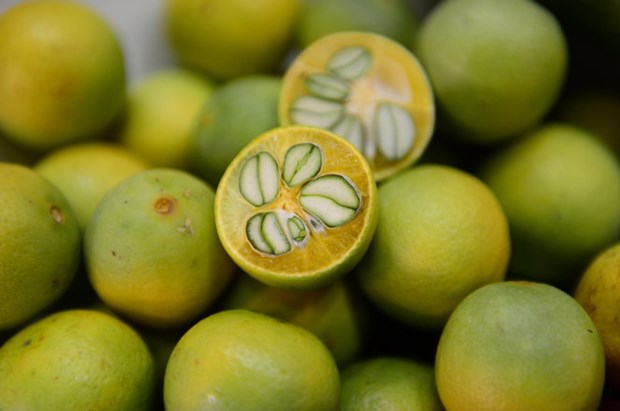
Dan oranges.
Do
not underestimate sauces
Rolled Coffer-fish (Ostraciidae) with sponge gourd leaves in
pink guava sauce wowed all foreign judges because it was too stimulating to
take.
Mr. Sakal Phoeung, Chairman of
Escoffier Viet Nam, commented “Impressive
taste! Must have a very good skill to retain this original taste during cooking
process.”
Furthermore, there were wild syrup
fruit sauce - which had a transparent and mild sour taste - served with rolled
beef marrow in lard and baked beef with vegetable, vinegar leaf sauce served
with Thun Mun leaves and avocado
saad, moringa leaf sauce, Xoan orange
sauce, and gamboge sauce.
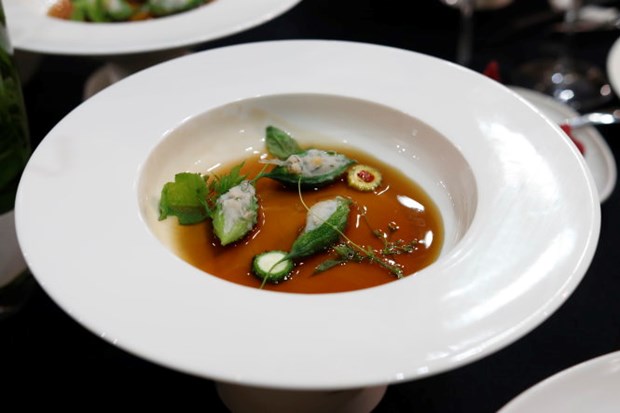
Young bitter melon stuffed frog paste.
Nganh leaves (Cratoxylum
cochinchinense) grow mostly in Middle
Highlands and have a sour taste. We can make a sour sauce out of it without
using limes or vinegar, adding chopped green onions and Ngo Gai leaves
then carefully sweetening the sauce by Jaggery just enough to keep that unique
sour taste.
In similarity, instead of
grilling, lobsters were boiled with Nganh leaves in coconut juice then
sautéed. The differences among sauces were from various cooking method to
create the best yet exotic tastes for dishes.
The more we have gone,
the more Vietnamese chefs’ creativity was discovered. Unlimited and bold inventions
have dragged the jury into the world of spices, in which each door opens to a
great sauce.
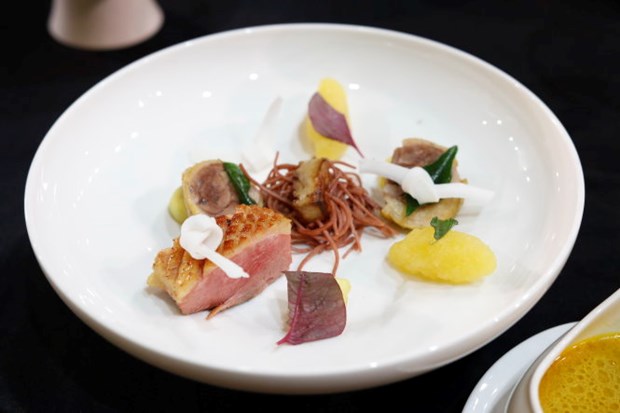
Modern styled Muscovy duck curry.
People who caress
flavors, both amateurs and experts, are the one putting their mind at cooking,
the one understanding that each dish is a world of spices.
Judge Trieu Thi Choi said
that there were many familiar spices that have not used in professional menu,
such as pepper leaves or papaya seeds. However, skillful hands of chefs brought
them to life in nutritious dishes, which absolutely can be on the same level of
Vietnamese cuisine.
By Nhu Binh/
Tuoi tre news